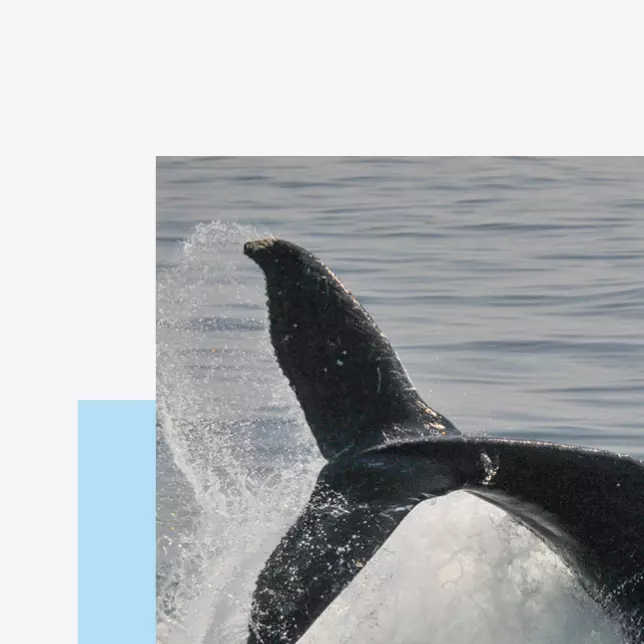As humans, we can learn from everything. Lessons about the human experience are everywhere if you’re open to them. If you’re a lover of nature like me, you know that it has a lot to teach us. In oceans worldwide, pods of humpback whales form veritable choirs, singing a unison song at 188 decibels. That’s louder than the roar of a jet plane flying only 100 feet away. But we humans, limited by our audio perception and utter lack of the whale’s use of language—pay no mind. And we should. The way whales communicate has a lot to say about communication and messaging.
Recently I snuggled in to watch the second episode of Disney+ and National Geographic’s brilliant documentary series, “Secrets of the Whales,” with my 8-year-old daughter. As the beautiful episode progressed, I was struck by the similarities between our work in employee experience and communication— and the astonishing ways whales communicate across their community.
If you watch the show (and trust me, it’s worth it!)—you’ll see that drawing a parallel between employee experience and whalesong isn’t as much of a stretch as you’d think. The focus of episode two is on the sophisticated ways that humpback whales communicate across vast distances. The males whales make up a new yearly song that can travel thousands of miles. They broadcast the same complex music across the ocean, reaching other whales as many as 10,000 miles away. As Sigourney Weaver points out in the episode, as the message spreads the art of the song is handed down. Slowly over time, the notes evolve. New songs never repeat, even over the years, but they do change.
It’s like the “American Idol” of the sea. It’s a bit of a singing competition where the males compete every year at the beginning of the year with a tune, and then one song gets to be the winning tune. And they adopt it, and everybody sings that exact song. They might add bits and pieces here and there, but they pass it across the earth’s oceans. According to National Geographic’s Secret of the Whales, it has been described in scientific papers as the horizontal transmission of culture.
Is any of this sounding familiar yet?
We sing the song for others to learn
Scientists have not yet deciphered the content of the humpback whales’ songs. But we know this: whales work to build community and forge culture. They’re using repetition to encourage familiarity. They sing to teach others the song, so it travels, virtually unchanged, around the world.
That’s our job, too! Messages that we share reverberate around the company and beyond. We might originate the message, but we make sure it reaches all of our internal customers and influencers and encourage them to pass it on. And, as it is for the whales, keeping the messaging, or “song,” intact is of utmost importance. We are good at scrambling messages on the second and third retelling, aren’t we? Whales don’t play “telephone” they way we do. They keep the message the same across the oceans until it’s time to start sending new ones.
Maintaining the core of the message across audiences is something we think about all the time. We need to keep our song pure and universal. We need to ensure the things we say about the company, the culture, the business climate, and the employee experience retain their integrity. And, since we know from the whales that chatter can travel great distances, it’s on us to keep rumors, stories, and other unproductive messages at bay by openly addressing the concerns they cause.
Pay attention to the comfort of repetition
Nearly all living beings find comfort and learn from repeated messaging. That’s another lesson for those of us in internal communications to take to heart. It must be reassuring to whales when they hear far-away songs they recognize. It connects them to communities they may never meet and other whales in their own pod. It shows them they’re a part of something greater than themselves and aren’t alone. We have that, too, in popular songs, movies, TV shows, and shared cultures. As kids, we shared stories, nursery rhymes, and schoolyard chants that brought us all together.
Say it loud, say it clearly, and say it often. Repeating messaging across workplaces—both digital and in-person, and more importantly, message consistency, helps keep employees feeling more secure. That’s human nature. “Consistency also helps to build a sense of certainty and certainty is something our brains crave,” said South African internal communications manager Werna Oberholzer. “When you have inconsistent messages floating around in your organization, it creates an uncertain work environment. Uncertainty, in turn, creates stress and affects performance and engagement. Being consistent in the messages you communicate will help you to build and strengthen trust internally.”
Adding fuel to the power of repetition, author and podcaster Adam Grant noted that data shows leaders are more likely to be criticized for under-communicating than for over-communicating. And good communication requires repetition. “Just when you’re tired of your message, it’s just starting to land,” he said.
Familiarity is a catalyst for inclusion

A song that everyone knows is a mainstay of relationship-building. Think about school fight songs, tunes you sang around a campfire, or even how many times, you bonded with others over a shared chorus like the Spongebob Squarepants theme song.
When we learn and repeat the messages of others, we’re being inclusive of other points of view, validating other voices, and welcoming others into our culture. And naturally, that goes two ways. Just as the whales teach their songs to others, so do they learn new ones to spread. In the business world, that familiarity may take different forms. For example, internal communication messaging should be consistent across the world (except for localization changes like language.) While the information may vary across regions, the messaging should stay the same.
Sing as a choir, not as a thousand soloists
One of the most intriguing facts about whale song is how whales work together to sing the same song for a whole year until another piece arrives. No one knows why whales work in harmony, but scientists believe it’s evidence of culture—which was previously thought to exist only in people. Because of the loudness of their song, everyone singing different, overlapping songs would result in a cacophony of sounds that would turn their messages into noise. Singing the same song represents order and cooperation, and whales must somehow understand that intuitively.
That’s a lesson for us communicators, too. If whales work to ensure they avoid a confusing jumble of overlapping songs, we should also take that to heart. We aren’t here to be soloists but to sing the same theme for the good of the message. There are times when solo voices are appropriate and welcome, but company messaging and tone should reflect a single voice—even if there are many communicators. Marketing often talks about having “one company, and one voice” when talking to customers, which is a critical part of comms. Bringing that to internal communication is vital to the organization’s success.
When you sing, sing like whales: loudly, together, with a purpose, and in harmony.




















